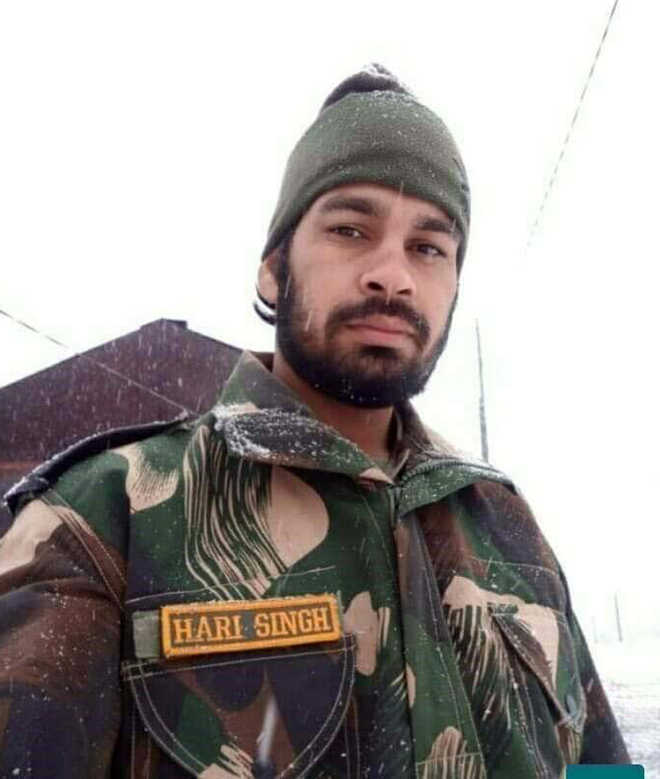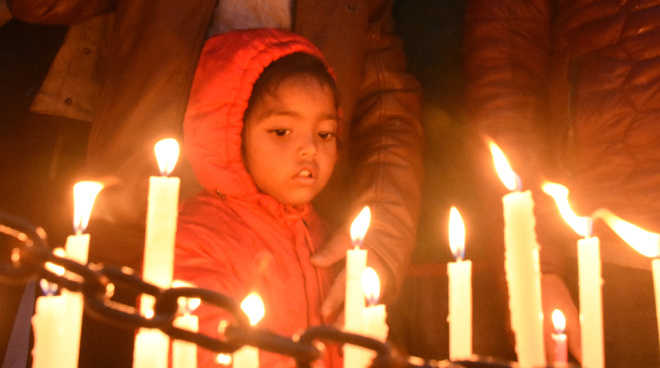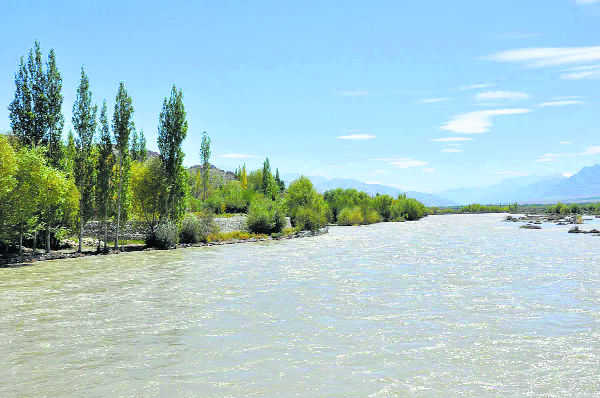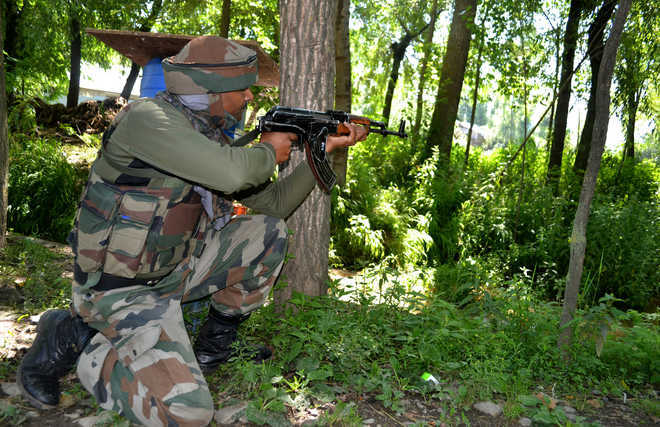










From a family of soldiers, 26-yr-old Sepoy Hari Singh was commended for ops in Kashmir

Ravinder Saini
Tribune News Service
Rewari, February 18
Sepoy Hari Singh (26) of the 55 Rashtriya Rifles, who lost his life in an encounter with terrorists at Pulwama district in Kashmir in the wee hours on Monday, was awarded a commendation letter by his commanding officer two months ago when he had shown exemplary courage during a special operation which led to the arrest of two Lashkar-e-Toiba militants in Kashmir on November 13, 2018.
A resident of Rajgarh village on the Haryana-Rajasthan border, Sepoy Hari Singh belonged to an Army family. His late father Havildar Agdi Singh served in the Grenadiers, while his uncle Vijay Singh retired as havildar and cousin Sunil Kumar is a serving havildar with the Central Reserve Police Force.
“Hari Singh was so passionate about the Indian Army that he started preparing to join the Army after matriculation instead of pursuing higher studies. His dream came true in 2011 when he got selected in the Army but the year also gave him a major setback as he lost his father during the training period,” the martyr’s cousin Ranjeet said, adding that he was the only brother of three sisters. The sepoy had got married in 2016 and was blessed with a boy in April 2018.
Rajesh Bholu, a close friend of the slain sepoy, said the latter had called him up three days ago and asked him to buy a toy for the 10-month-old Lakshya. “Hari was very patriotic since childhood and always talked about the condition of Kashmir when he came to the village. He motivated me to join the Army saying that no other service is bigger than fighting for the nation,” said Bholu, who is preparing for recruitment into the Army.
Govardhan, sarpanch of Rajgarh, said the soldier’s mother and wife had not yet been informed about his martyrdom. “We have just told them that Hari Singh has suffered injuries during an operation,” he said, adding that the body would be brought to the village on Tuesday.
Told friend to buy toy for son 3 days ago
A close friend of the martyred sepoy, Rajesh Bholu, said the soldier had called him up three days ago and asked him to buy a toy for his 10-month-old son Lakshya.
CM expresses grief
In a condolence message, CM Manohar Lal Khattar, saluting the bravery of Sepoy Hari Singh, said soldiers from Haryana had always made sacrifices for the country.
Commendation letter to braveheart in Nov 2018
Dear Hari
This achievement exhibits your uncanny courage and professional skill which has made proud every member of 20 Grenadiers family. We are proud of your valour and this motivational result would encourage all ranks of our battalion.
Colonel RB Alavekar, Commanding Officer, 20 Grenadiers

Tribune News Service
Shimla, February 15
The Himachal Vidhan Sabha today paid tributes to the martyred CRPF personnel in Kashmir and condemned the cowardly attack by militants.
Chief Minister Jai Ram Thakur moved a resolution, offering condolences to the family of the martyrs. “Even though the militant outfits have tried to shatter the morale of the armed forces by killing 42 CRPF men our valiant soldiers will give a befitting reply to this ghastly act,” he said.
The Chief Minister announced an ex-gratia of Rs 20 lakh to the family of CRPF jawan Tilak Raj from Jawali area of Kangra, who died in the attack. “The government will provide all possible help to the family of the bereaved who made the supreme sacrifice for the nation,” he said.
“It is Pakistan which is the mastermind of the attack and the whole nation is with Prime Minister Narendra Modi, who must ensure that our forces give a befitting reply,” he said. He said this was an attempt to create instability in the nation but the while nation is united in this hour of grief.
Vidhan Sabha Speaker Dr Rajeev Bindal also expressed his condolences to the bereaved family of Tilak Raj.
Offering condolences to the martyrs, Leader of Opposition Mukesh Agnihotri said this was a big challenge thrown by militant outfits but the entire nation is one against such forces. “The army, para-military forces and its establishments are being continuously targeted by the military so it is essential that a befitting reply is given to such forces,” he said.
Former Chief Minister Virbhadra Singh also offered condolences to the families of the martyrs and said that the entire nation is one in its fight against such forces.
“The act close to Srinagar has proved that it is not just external forces but some elements within Jammu and Kashmir who are supporting the militants in this cause,” he lamented.
Other legislators including Irrigation and Public Health Minister Mahender Singh, Col Dhani Ram Shandil (retd), Col Inder Singh (retd), Rakesh Pathania, Nand Lal, Suresh Kashyap, Vikram Jaryal, Vikramaditya Singh and Ashish Butail offered condolences to the family of Tilak Raj and condemned the attack.
The Vidhan Sabha was adjourned for the day after offering condolences to the 42 bravehearts.
Candle march
Residents of Mandi district paid tributes to the bravehearts killed in Pulwama terror attack by lighting candles. Most demanded stern action against those responsible for the ghastly act. In Lahaul-Spiti, employees of the DC office also observed silence.
Cong condemns attack
SRINAGAR: The Army paid befitting tributes to Havildar Baljeet Singh who was killed in a gunfight in Pulwama on Tuesday. In a solemn ceremony at Badamibàgh Cantonment, Chinar Corps commander Lt Gen KJS Dhillon and all ranks paid homage to the soldier on the behalf of a proud nation, an Army statement said. “Havildar Baljeet Singh sustained bullet injuries during a fierce operation at Ratnipora village. He was provided first aid and shifted to 92 Base Hospital, but unfortunately he succumbed to his injuries,” it added. Baljeet, 35, had joined the Army in 2002. He belonged to Dinger Majra village of Karnal district, Haryana. He is survived by his wife, daughter and son. TNS

Panaji, February 14
A 46-year-old senior naval officer posted in Goa had been booked for allegedly molesting his domestic help, police said on Thursday.
The maid filed a complaint of molestation and sexual harassment against Commodore Mankandan Nambiar, posted at the INS Hansa naval base here, on Wednesday, Vasco police station inspector Nolasco Raposo said.
In the complaint, the woman accused the officer of molesting her at his private residence in Vasco town, located around 40 km from here in South Goa district, he said.
The officer has been booked under Indian Penal Code Sections 354 (assault or criminal force on woman with an intent to outrage her modesty), 354-A (sexual harassment) and 354-B (assault or use of criminal force on woman with an intent to disrobe), he said.
After the officer was booked, he moved a local court for anticipatory bail, the police added. PTI
Pakistan is facing a water crisis due to poor management and anticipated reduction in intake through the nine trans-border rivers from Afghanistan and in the Indus river from China. Pakistan’s allegation that India is trying to usurp its share of water by constructing hydel power plants on the western rivers is not based on facts.

Lt Gen Pramod Grover (retd)
Former Information Commissioner, Punjab
THE Indus Waters Treaty, signed by India and Pakistan in 1960, mandates the commissions of both countries to inspect sites and works on both sides of the Indus basin in a block of five years. Honouring this obligation, a Pakistani delegation recently visited the Chenab river basin in Jammu and Kashmir for an inspection. Since the signing of the treaty, 118 such tours on both sides have been undertaken. The last tours of the commissions in Pakistan and India were conducted in July 2013 and September 2014, respectively. The current five-year block ends in March 2020.
During the bilateral talks on the treaty in Lahore in August last year, India, rejecting Pakistan’s objections to the construction of the Pakal Dul and Lower Kalnai hydroelectric power projects (HEPs) on the Chenab river, had invited Pakistani experts to visit the sites to address their concerns regarding the impact on the flow of water into their country.
The Pakul Dul project (1,000 MW, ultimately 1,500 MW) is located on the Marusadar river, a major right-bank tributary of the Chenab Main, in Doda district. The confluence of the Marusadar and Chenab is 225 km upstream of the Marala headworks and 76 km from the Baglihar HEP. A concrete-faced rock fill dam with a height of 167 metres is being constructed at a cost of Rs 8,110 crore. Pakul Dul will not only be the largest hydroelectric power project in Jammu and Kashmir, but will also have the first storage unit. Also, subsequent to its commissioning, Jammu and Kashmir will get 12 per cent free power after 10 years.
The Lower Kalnai HEP is located on the left-bank tributary of the Chenab, about 19 km downstream of Dulhasti HEP and 180 km upstream of the boundary between Pakistan and India. A concrete gravity dam with a height of 34 metres is proposed to be constructed with an installed capacity of 48 MW.
Pakistan has raised technical issues, alleging that the design parameters constitute a violation of the restrictions imposed as per the treaty. Pakistan has objected to the designs of the projects — freeboard, pondage, spillway and intake crest elevation.
India, however, has rejected such assertions, stating that the projects were being built in adherence to the parameters laid down in the treaty. As against 3.6 MAF (million acre ft) which India can store on the western rivers, the total storage capacity created so far is a mere 0.5 MAF. Pakal Dul is a storage project with a capacity of 88,000 acre ft, but this is within the permissible limit of storage of 0.6 MAF on the tributaries of the Chenab. The gross storage capacity of Lower Kalnai (1,508 acre ft) is so small that it has negligible downstream impact on Pakistan. Other design differences are small and not of much significance with respect to downstream impacts.
Water is becoming an existential issue for Pakistan. The country is facing a grim situation regarding its fast-depleting fresh water resources. Pakistan has been attributing its problems of water scarcity to Indian action of constructing hydel projects on the western rivers. In Pakistan’s perception, the construction of dams by India could lower the quantity of water in these rivers.
However, their water-related problems need to be attributed to Pakistan having drawn limited benefit of India’s benevolence, despite the fact that it has been receiving more than its authorised share. Projects being undertaken by India are in tune with the provisions of the treaty. In 1950, the water available per capita annually was 5,500 cubic metres when the population of the erstwhile West Pakistan was 33 million; at present, it is down to 850 cubic metres annually, while the population has increased to 210 million. The overall quantity of water flowing in the western rivers to Pakistan remains approximately the same. As per a recent report, Pakistan is receiving about 154 MAF of water annually against an authorisation of 136 MAF.
As far as India is concerned, the Kashmir dispute and the water dispute are inextricably intertwined. Pakistan’s attempts over the years to annex Kashmir can be seen in the context of attempts to ensure water security. Despite India’s generosity in the sharing of the Indus river waters, Pakistan has consistently adopted an obstructionist strategy since 1977, raising issues regarding run-of-river projects under construction on the western rivers by India.
Such an attitude has not only stressed the treaty itself, but also has had a considerable negative impact on the economic progress of Jammu and Kashmir. The state, even though being upper riparian, exploits merely one-seventh of its hydel power potential. India, at present, irrigates 0.8 million acres area against the limitation imposed on the extent of area to be irrigated (1.32 million acres) with the waters of the western rivers. The annual energy loss suffered by Jammu and Kashmir is 60,000 million units; evaluated at the rate of Rs 2 per unit, it is approximately Rs 12,000 crore. These restrictions have, therefore, imposed a loss in terms of development of industry, power and agriculture equal to around Rs 40,000 crore annually.
The World Economic Forum rates the water crisis as the biggest risk in Pakistan, with terrorist attacks third on the list. Pakistan is facing the crisis due to poor management and anticipated reduction in intake through the nine trans-border rivers from Afghanistan and in the Indus river from China. The reduction in discharge is the result of construction of hydel power projects with storage facilities by Afghanistan and China. Shortage of water in Pakistan, thus, has very little to do with the non-adherence of the provisions of the treaty by India. As such, its allegation that India is trying to usurp its share of water by constructing hydel power plants on the western rivers is not based on facts.
A recent report of the World Bank puts into perspective the massive wastage of water in Pakistan. Water worth $25 billion flows into the sea annually. As per the report, agriculture, which consumes more than 80 per cent of water, contributes less than 5 per cent of the GDP. Pakistan needs to initiate necessary action on its own to improve the water availability to overcome the crisis.
New Delhi: It is perhaps the biggest decision the Army Chief, General Bipin Rawat, has made in his efforts to restructure the 1.2 million force, to make it lean-and-mean, a 21st-century fighting unit. ARTRAC, or the Army Training Command, one of the seven in the army, will be moved from its headquarters in Shimla to Ambala in the next six months. This comes along with the decision to merge the Directorate of Military Training, currently in Army HQ in New Delhi, with ARTAC.
Importantly, ARTRAC, in Shimla since the early 1990s, and the place where future military doctrines are worked out, will need to liaison more with field formations, interact more with fighting units. “It is important for theoreticians to work with people who are part of the field army. It should not be out on a limb in Shimla,” a top official said. And in Ambala, is the headquarters of 2 Corps, one of the Army’s three strike corps.
nteraction with field formations apart, the 150 officers and several thousand men in ARTRAC, should also be more in touch with Army HQ and Ambala brings it closer. Which brings up the logistics issue. The Army is readying for a swap: a sub-area in Ambala, a smaller outfit that looks are Haryana, Punjab, and Himachal, moves to Shimla, while ARTRAC comes to Ambala.
The Army’s future restructuring plans are already with the defence ministry. Other important decisions relate to the cutting of 1.5 lakh troops, a third of it by the end of this year, the merger of various units, the moving of Rashtriya Rifles directorate to Jammu and Kashmir, and interestingly, the virtual abolition of the post of brigadier, allowing colonels to be promoted directly to major-general rank, apart from those who would temporarily and for strictly operational reasons, be brigadiers when they are commanding brigades or independent battle groups as they would be renamed.
The final decision now rests with first, the defence ministry and then, the government.

Ludhiana, February 2
The Ludhiana police today booked two persons, including an ex-serviceman, for their alleged involvement in an Army recruitment racket.
Ex-serviceman Mohinder Singh, who was Havildar in 103 Infantry Battalion, TA, and Surinder Pal, a resident of Chomon village in Jalandhar and a messenger in the Civil Defence Department, were booked on the complaint of Col Vishal Dubey, Director, Army Recruiting Office (ARO), Ludhiana.
Col Dubey alleged that the accused had facilitated the entry of many aspirants into the Army by preparing fake documents. When the matter reached the ARO, a probe was initiated in which the duo’s role came to light.
ASI Chand Aheer said Pal did not let the forged documents of aspirants reach the departments concerned for verification. He used to open the official mails and put the fake stamps to give the impression that the documents were duly verfied.
The Roopnagar police had recently busted a gang involved in preparing fake documents to secure the entry of ineligible youths into the Army. The Ludhiana police are probing whether the two accused have any links with the gang. — TNS

Photo for representation only.
Tribune News Service
Srinagar, February 1
Two militants were killed in a late night encounter with security forces in Drubgam area of Pulwama district of Jammu and Kashmir.
Security forces launched a cordon and search operation in Pulwama following information about presence of militants in the area, a police official said.
He said a gun battle ensued as the militants opened fire at the security forces.
Two militants were gunned down, the official said, adding that their identities and group affiliation were being ascertained. With PTI inputs

The CAG report tabled in Parliament recently tells us that the Indian Air Force wanted the Rafale fighter jets from day one. In fact, it wanted a jet from Dassault Aviation.
But the question is: Why?
Let us go back to the Kargil war in 1999. The Dassault Mirage 2000 aircraft proved its capabilities and impressed the Air Force very much. In August 2000, the Air Force proposed the acquisition of 126 upgraded Mirage 2000 jets. This was shot down by the defence ministry as the Defence Procurement Procedure (DPP) 1992 did not allow for a single-vendor purchase. The Air Force re-submitted its proposal in December 2001, saying it should be treated as a repeat purchase.
However, the insistence of the government to not get into a single-vendor deal led to a request for information (RFI) being issued for the acquisition of 126 medium-range combat aircraft. It largely consisted of single-engine jets: Dassault Mirage 2000-5 Mk.2, Lockheed Martin F-16, Mikoyan MiG-29, and Saab JAS 39 Gripen. Only the MiG-29 had twin engines.
But once Dassault closed the Mirage production and insisted on fielding only the Rafale, the acquisition was expanded to what became the Medium Multirole Combat Aircraft or the MMRCA. This also got Boeing F-18 and the Eurofighter Typhoon into the competition. Russia changed its offering to the MiG-35.
Also read: India favoured Rafale also because of its ‘nuclear advantage’
The Request for Proposal (RFP) was issued to all these contenders in August 2007, with a demanding Air Staff Qualitative Requirement (ASQR), which led to most of the contending jets not satisfying it, warranting certain India-specific enhancements.
This was a drastic change from the IAF’s own argument as reported by the Comptroller and Auditor General (CAG) in March 2001 while re-submitting its proposal for Mirage 2000, in which the IAF had argued that “while other available options such as Rafale, Eurofighter, F-35, etc., were technologically superior to Mirage 2000, the excess combat capability of these aircraft would remain underutilised as Air Force requirement was a comparatively modest aircraft for shorter range missions.”
Although the IAF ran flight trials, none of the contenders were completely in compliance with its ASQR. The CAG report states: “In the Technical Evaluation conducted in May 2008, five of the six aircraft could not meet all the ASQR parameters. Four aircraft had one to two deviations. Rafale aircraft could not meet 9 ASQR parameters prescribed in the RFP.” On three separate occasions in 2009, the Rafale was rejected, but it managed to remain in the hunt in complete violation of the Defence Procurement Procedure.
Four aircraft were eliminated after the flight trials — the F-18, F-16, MiG-35 and the Gripen — because they did not meet the ASQR parameters of “growth potential” and “design maturity”. The CAG says: “There was no objective, verifiable or measurable criteria prescribed for evaluation of these parameters.”
However, the Rafale, which did not satisfy 14 parameters, made it to the IAF’s down select along with the Eurofighter. It is apparent that the IAF did not want certain jets. It didn’t want the American jets as it argued that “it could face difficulties in case sanctions were imposed by (the) USA”.
Also read: Buying complex weaponry is no easy business, but Rafale shows India’s process is broken
The IAF has since bought aircraft and helicopters from the US — the C-130, C-17, Apache and Chinook. The Indian Navy bought P8 aircraft. The Russian MiG-35 was not in the game at all as the IAF didn’t want Russian jets, which are notorious for high maintenance and operational costs — one of the reasons why lifecycle cost was the criteria in the RFP, as Russian jets are cheaper in direct acquisition costs but costlier in the long run.
A comparison can be taken from the CAG report on heavy lift helicopter acquisition. Total Life Cycle cost quoted by Boeing for Chinook helicopters was $1.47 billion and that by Rosoboronexport for Mi-26 was €8.40 billion. Direct acquisition cost was $1.20 billion and €1.06 billion, respectively.
The CAG report says that Dassault was non-compliant in ASQR, RFP and in violation of the DPP. It did not give complete information, and the columns it had left blank were filled by the Indian committee looking into lowest bidder (L1) under various assumptions.
Dassault Aviation was declared L1 and Eurofighter, which had provided all the details, was found to be L2! It was only during negotiations that it became apparent that the costs were going way beyond the quote, and the Dassault was no longer L1.
According to the CAG report, a team of defence ministry officials had submitted a report in March 2015, saying that Dassault’s bid should have been rejected at the technical evaluation stage. It said, “The acceptance of additional commercial proposal after bid submission date for capabilities, which were already prescribed in the RFP, was unprecedented and against the canons of financial propriety.”
Also read: The 4 IAS officers in the thick of the Rafale deal controversy
Yet, just days later on April 10, 2015, Prime Minister Narendra Modi announced a deal for 36 Rafale. Was the PM not aware of the defence ministry’s report? Or did he go ahead regardless hoping for a better deal? CAG report does not indicate a better deal. It is Dassault that laughed all the way to the bank.
Various reasons are attributed to why the IAF wanted the Rafale — comfort with Dassault, Indo-France strategic ties, procuring weapons from France that are seen as sanctions proof and also a nuclear weapons delivery role.
This raises questions on the gaps that exists in understanding the needs and reasons of the IAF and the armed forces in general for certain weapons systems with the civilian leadership. If the IAF wanted only the Mirage and later the Rafale, then why wasn’t a government to government deal done earlier? DPP-2006 allows for an inter-governmental agreement.
If an IGA had been done in 2007, the Rafale jets would have been a lot cheaper and the Air Force would have already had the 126 jets it requires. In fact, the total requirement is 200-250 Rafale kind of jets. There was no need to have a sham tender that made a mockery of procedures and rules, because this has sent a very wrong message to weapons’ manufacturers across the world.
India is going to run what is dubbed MMRCA 2.0. It has got responses from the same contenders as MMRCA 1.0. The CAG report will be read by foreign suppliers. They will see how the MRCA tender played out. A competing vendor told noted defence journalist Saurabh Joshi, “If you’re permitting cheating, at least have the decency to not make the rest of us work so hard.” Will they respond to the RFP that’s due to be released?
Yusuf T. Unjhawala is the editor of Defence Forum India and a commentator on defence and strategic affairs. He tweets @YusufDFI
From interviews to news reports, catch ThePrint live in action on our YouTube channel. Subscribe here .

























































